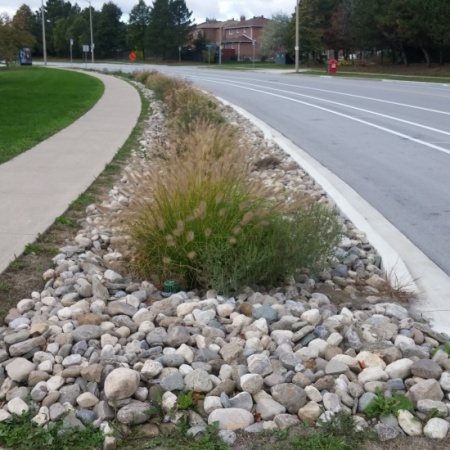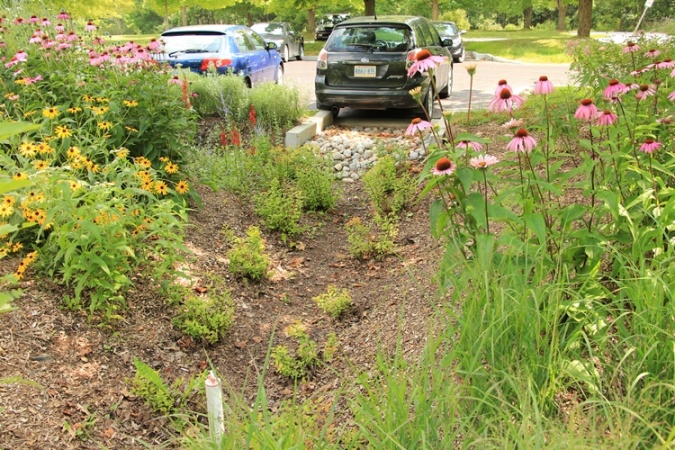Difference between revisions of "Swales"
Jenny Hill (talk | contribs) |
Jenny Hill (talk | contribs) |
||
| Line 4: | Line 4: | ||
===Overview=== | ===Overview=== | ||
<p>Swales are linear landscape features consisting of a drainage channel with gently sloping sides. Underground they may be filled with engineered soil and/or contain a water storage layer of coarse gravel material. Two variations on a basic swale are recommended as low impact development strategies, although using a combination design of both may increase the benefits:<br> | <p>Swales are linear landscape features consisting of a drainage channel with gently sloping sides. Underground they may be filled with engineered soil and/or contain a water storage layer of coarse gravel material. Two variations on a basic swale are recommended as low impact development strategies, although using a combination design of both may increase the benefits:<br> | ||
<strong>Bioswales</strong> are sometimes referred to as 'dry swales', 'vegetated swales', 'water quality swales' or 'inline bioretention'. This type of structure is similar to a [[Bioretention cells|bioretention cell]] but with a linear shape (typically >2:1 )<br> | <strong>Bioswales</strong> are sometimes referred to as 'dry swales', 'vegetated swales', 'water quality swales' or 'inline bioretention'. This type of structure is similar to a [[Bioretention cells|bioretention cell]] but with a long linear shape (surface area typically >2:1 )<br> | ||
<strong>Enhanced Grass Swales</strong> are a lower maintenance alternative, but generally have lower stormwater management potential. The enhancement over a basic grass swale is in the addition of check dams to slow surface water flow and create small temporary pools of water which can infiltrate the underlying soil. | <strong>Enhanced Grass Swales</strong> are a lower maintenance alternative, but generally have lower stormwater management potential. The enhancement over a basic grass swale is in the addition of check dams to slow surface water flow and create small temporary pools of water which can infiltrate the underlying soil. | ||
</p> | </p> | ||
| Line 27: | Line 27: | ||
<p><strong>The fundamental components of a swale are:</strong> | <p><strong>The fundamental components of a swale are:</strong> | ||
<ul> | <ul> | ||
<li> | <li> Graded channel</li> | ||
<li> | <li> Planting </li> | ||
</ul> | </ul> | ||
<strong>Additional components may include:</strong> | <strong>Additional components may include:</strong> | ||
<ul> | <ul> | ||
<li>Biomedia - an engineered soil mix</li> | <li>Biomedia - an engineered soil mix</li> | ||
<li>Underdrain with clean out and inspection ports</li> | <li>Underdrain with clean out and inspection ports</li> | ||
<li>Impermeable membrane to prevent infiltration to soils below</li> | <li>Impermeable membrane to prevent infiltration to soils below</li> | ||
Revision as of 19:30, 27 June 2017
This article is about installations designed to capture and convey surface runoff along a vegetated channel.
Overview[edit]
Swales are linear landscape features consisting of a drainage channel with gently sloping sides. Underground they may be filled with engineered soil and/or contain a water storage layer of coarse gravel material. Two variations on a basic swale are recommended as low impact development strategies, although using a combination design of both may increase the benefits:
Bioswales are sometimes referred to as 'dry swales', 'vegetated swales', 'water quality swales' or 'inline bioretention'. This type of structure is similar to a bioretention cell but with a long linear shape (surface area typically >2:1 )
Enhanced Grass Swales are a lower maintenance alternative, but generally have lower stormwater management potential. The enhancement over a basic grass swale is in the addition of check dams to slow surface water flow and create small temporary pools of water which can infiltrate the underlying soil.
Swales are an ideal technology for:
- Sites with long linear landscaped areas, such as parking lots
- Connecting with one or more other types of LID
| Property | Bioswale | Enhanced Grass Swale |
|---|---|---|
| Surface water | Minimal Any surface flow can be slowed with check dams | Ponding is encouraged with check dams |
| Engineered soil | Biomedia required | Amendment preferable when possible |
| Underdrain | Common | Uncommon |
| Maintenance | Medium to high | Low |
| Stormwater benefit | High | Medium |
| Biodiversity benefit | Increased with native planting | Lower |
The fundamental components of a swale are:
- Graded channel
- Planting
Additional components may include:
- Biomedia - an engineered soil mix
- Underdrain with clean out and inspection ports
- Impermeable membrane to prevent infiltration to soils below
- Check dams
Planning Considerations[edit]
Planning Content
Design[edit]
Design Content
<panelSuccess>
</panelSuccess>
Performance[edit]
Performance Content
Incentives and Credits[edit]
In Ontario
City of Mississauga
The City of Mississauga has a stormwater management credit program which includes RWH as one of their recommended site strategies[1].
LEED BD + C v. 4
SITES v.2
See Also[edit]
External Links[edit]
| SEND US YOUR QUESTIONS & FEEDBACK ABOUT THIS PAGE |

